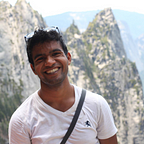SF Marathon: A failure to learn from
I ran the San Francisco marathon today with a swiss-army knife of cramp-prevention mechanisms. I took salt pills, high sodium gus, extra electrolyte drink, and pickle juice. All of them failed, as did I.
That sounds angsty, but I mean it in the healthiest way possible. I set out a list of three goals for this race, and didn’t accomplish any of them. As I come down from the sugar and caffeine high, from the high fives and nice-jobs, I keep repeating this phrase to myself: “Failure is an action, not an identity.”
I realized a few months ago that muscle cramps are the biggest obstacle standing in the way of me and my marathon goal. The San Francisco marathon was my first serious attempt to overcome this obstacle. I tried all the easy things, like better nutrition, and I have given up on them. Next is the hard things: Higher mileage, more marathon-pace long runs, and running races slower than my projected best pace.
But wait. Before I get to planning what’s next, to setting up a training plan, to being positive and constructive, I want to acknowledge the voice in the back of my head: I don’t know if this is possible. I don’t know if I’ll figure out this cramping issue, and I don’t know if I’m capable of running a 2:37 marathon. It’s completely possible that I don’t have the physiology to accomplish these goals.
In order to have and achieve aggressive goals, you must have selective vision. In setting a goal of a 2:37 marathon, I think about the training required, the people I know who could help me, and the race times that indicate that I’m making progress. I don’t think about the amount of time it will take, the opportunity cost, or the chance that this goal is not possible to accomplish. I prefer to live in this half blind state, and think it’s a great way to tackle difficult goals. Right now, however, it feels like the curtain has lifted and, in a small way, I’m seeing my own mortality.
But somehow my determination hasn’t faded. Were it not for the fact that my legs are lead, I would love to hit the track tonight. I believe that becoming is better than being, and this struggle to run a successful marathon is good for me. So what’s next?
First, I’d like to run a half marathon in the next few months. At mile 22 of this race, I was conversational, lucid, and felt basically great, aside from the debilitating cramping. I’m craving a struggle with something other than my misfiring muscles.
Next, I need a new approach to the marathon: I know I can run 26.2 at a 7 minute pace, and I know I cannot run it at my predicted marathon pace (determined by other race times). So I need to run a marathon at a taxing pace, but still a few notches below my anticipated best effort. I’ll probably attempt this at the California International Marathon in December this year. The tentative plan is to train for a 6-minute pace marathon, then race at a 6:15 pace. I suspect this will work because of my experience in The Woodlands Marathon, where I shot for a 6:20 pace (modest compared to my fitness level), and didn’t get muscle cramps until mile 23.
In spite of failing in my goals for SF, this race was so much fun. Running single-file past Fort Mason in the dead of the night was surreal. Passing the 2nd half marathoners, who started early this year, was like real-life frogger. And this race marked the return to my first ever marathon: I improved my time by 1 hour and 10 minutes. Not bad!
